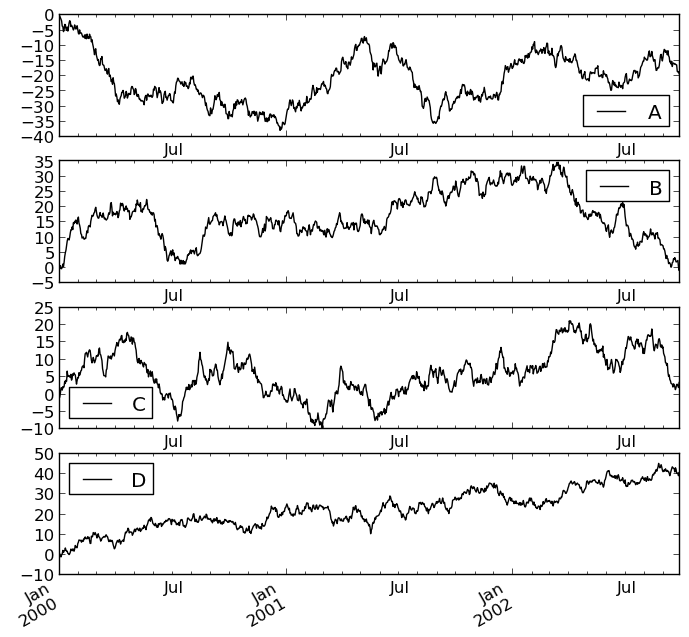43 pandas series get labels
Pandas Series Attributes - AlphaCodingSkills - Java Series attributes reflect information that is intrinsic to the series. Accessing a series through its attributes allows us to get the intrinsic properties of the series. Most commonly used attributes are mentioned below: Function. Description. Series.dtype. Return the dtype object of the underlying data. Series.empty. Convert Pandas Series to a List - Data Science Parichay There are a number of ways to get a list from a pandas series. You can use the tolist () function associated with the pandas series or pass the series to the python built-in list () function. The following is the syntax to use the above functions: # using tolist () ls = s.tolist() # using list () ls = list(s)
Python | Pandas Series.get() - GeeksforGeeks As we can see in the output, the Series.get () function has returned the value corresponding to the passed index label. Example #2 : Use Series.get () function to get the value for the passed index label in the given series object. import pandas as pd sr = pd.Series ( [11, 21, 8, 18, 65, 84, 32, 10, 5, 24, 32])

Pandas series get labels
7 Reindexing and altering labels — Pandas Doc - GitHub Pages reindex () is the fundamental data alignment method in pandas. It is used to implement nearly all other features relying on label-alignment functionality. To reindex means to conform the data to match a given set of labels along a particular axis. This accomplishes several things: Reorders the existing data to match a new set of labels How to print x-axes labels in pandas.Series.plot()? Having a look at the Pandas plot method (on the DataFrame object), we can see that it returns a matplotlib Axes object. Try something like this: ax = df.groupby ('owner_team').inc_subj.count ().plot.bar (ylim=0) ax.set_xticklabels (df.owner_team) # if they are still present as strings A Practical Introduction to Pandas Series | by B. Chen - Medium A practical introduction to Pandas Series (Image by Author using canva.com). DataFrame and Series are two core data structures in Pandas.DataFrame is a 2-dimensional labeled data with rows and columns. It is like a spreadsheet or SQL table. Series is a 1-dimensional labeled array. It is sort of like a more powerful version of the Python list.Understanding Series is very important, not only ...
Pandas series get labels. pandas: Select rows/columns in DataFrame by indexing "[]" You can select and get rows, columns, and elements in pandas.DataFrame and pandas.Series by indexing operators (square brackets) []. This article describes the following contents. You can also select columns by slice and rows by its name/number or their list with loc and iloc. The following CSV file is used in this sample code. Modifying a Series in-place | Learning pandas - Second Edition The value at a specific index label can be changed in place by assignment: Rows can be removed from a Series by passing their index labels to the del () function. The following demonstrates removal of the row with the index label 'a': To add and remove items out of place, you use pd.concat () to add and remove using a Boolean selection. Pandas select rows: How to Select Rows from Pandas DataFrame Step 1: Data Setup. Pandas read_csv () is an inbuilt function used to import the data from a CSV file and analyze that data in Python. So, we will import the Dataset from the CSV file, which will be automatically converted to Pandas DataFrame, and then select the Data from DataFrame. The data set for our project is here: people.csv. pandas.Series.loc — pandas 1.4.2 documentation pandas.Series.loc ¶ property Series.loc ¶ Access a group of rows and columns by label (s) or a boolean array. .loc [] is primarily label based, but may also be used with a boolean array. Allowed inputs are: A single label, e.g. 5 or 'a', (note that 5 is interpreted as a label of the index, and never as an integer position along the index).
Python Tryit Editor v1.0 - W3Schools x 1 y 7 z 2 dtype: int64 ... Run Get your own website Result Size: 497 x 414 How to prefix string to a pandas series labels? - Tutorials Point It will add the given string before the row labels of the series. Example import pandas as pd series = pd.Series (range (1,10,2)) print (series) # add Index_ prefix to the series labels result = series.add_prefix ('Index_') print ("Prefixed Series object with a string: ", result) Explanation Convert pandas.DataFrame, Series and list to each other After generating pandas.DataFrame and pandas.Series, you can set and change the row and column names by updating the index and columns attributes.. pandas: Rename columns/index names (labels) of DataFrame; For list containing data and labels (row/column names) Here's how to generate pandas.Series from a list of label and value pairs.. Break it down into a list of labels and a list of values ... Python | Pandas Series.keys() - GeeksforGeeks As we can see in the output, the Series.keys () function has returned all the index labels of the given series object. Example #2 : Use Series.keys () function to return the index labels of the given series object. import pandas as pd sr = pd.Series ( [11, 21, 8, 18, 65, 84, 32, 10, 5, 24, 32])
Pandas Series: How to Use Series In Python - AppDividend Unlike Python lists, the Series will always contain data of the same type. This makes NumPy array the better candidate for creating a pandas series. Let's create a series using the NumPy library. # app.py import pandas as pd import numpy as np data = np.array ( [ 'a', 'b', 'c', 'd' ]) seri = pd.Series ( data ) print (seri) In the above ... pandas.Series — pandas 1.4.2 documentation pandas.Series — pandas 1.4.2 documentation pandas.Series ¶ class pandas.Series(data=None, index=None, dtype=None, name=None, copy=False, fastpath=False) [source] ¶ One-dimensional ndarray with axis labels (including time series). Labels need not be unique but must be a hashable type. Python | Pandas Series - Tutorialspoint.dev Pandas Series is a one-dimensional labeled array capable of holding data of any type (integer, string, float, python objects, etc.). The axis labels are collectively called index. Pandas Series is nothing but a column in an excel sheet. Labels need not be unique but must be a hashable type. Pandas: Get label for value in Series Object - Stack Overflow 8 May 2013 — How is it possible to retrieve the labe of a particular value in a pandas Series object: For example:1 answer · Top answer: You can get the subseries by: In [90]: s[s==12] Out[90]: d 12 dtype: int64 Moreover, you can get those labels by In [91]: s[s==12].index Out[91]: Index([d], ...Pandas get the "index" label of a series given an index - Stack ...26 Nov 2015Get pandas series labels of true values without storing the ...27 Jun 2020How do I know a row label of a series of pandas dataframe?27 Jul 2020How to get labels from Pandas Dataframe - python - Stack ...10 Dec 2019More results from stackoverflow.com
Pandas Series: idxmax() function - w3resource Get the row label of the maximum value in Pandas series . The idxmax() function is used to get the row label of the maximum value. If multiple values equal the maximum, the first row label with that value is returned. Syntax: Series.idxmax(self, axis=0, skipna=True, *args, **kwargs) Parameters: Name Description
Labeling your axes in pandas and matplotlib Specify axis labels with pandas. When you plot, you get back an ax element. It has a million and one methods, two of which are set_xlabel and set_ylabel. # Draw a graph with pandas and keep what's returned ax = df. plot (kind = 'scatter', x = 'GDP_per_capita', y = 'life_expectancy') # Set the x scale because otherwise it goes into weird negative numbers ax. set_xlim ((0, 70000)) # Set the x ...

python - Pandas matplotlib plotting, irregularities in time series labels between bar graph and ...
How to get the index and values of series in Pandas? A pandas Series holds labeled data, by using these labels we can access series elements and we can do manipulations on our data. However, in some situations, we need to get all labels and values separately. Labels can be called indexes and data present in a series called values. If you want to get labels and values individually.
How to get the names (titles or labels) of a pandas data ... - MoonBooks Active October 21, 2019 / Viewed 29622 / Comments 0 / Edit Examples of how to get the names (titles or labels) of a pandas data frame in python Summary Get the row names of a pandas data frame Get the row names of a pandas data frame (Exemple 1) Get the row names of a pandas data frame (Exemple 2)
Pandas Select Rows by Index (Position/Label) Use pandas.DataFrame.loc [] to Select Rows by Index Labels By using pandas.DataFrame.loc [] you can select rows by index names or labels.
how to Access the elements of a Series in python - pandas Accessing data from series with Labels or index: A Series is like a fixed-size dictionary in that you can get and set values by index label. Retrieve a single element using index label: # create a series import pandas as pd import numpy as np data = np.array(['a','b','c','d','e','f']) s = pd.Series(data,index=[100,101,102,103,104,105]) print s ...
Pandas Series: drop() function - w3resource Pandas Series: drop() function Last update on May 28 2022 11:28:45 (UTC/GMT +8 hours) Remove series with specified index labels. The drop() function is used to get series with specified index labels removed. Remove elements of a Series based on specifying the index labels. When using a multi-index, labels on different levels can be removed by ...
pandas.Series.loc — pandas 0.25.0.dev0+752.g49f33f0d documentation Access a group of rows and columns by label (s) or a boolean array. .loc [] is primarily label based, but may also be used with a boolean array. Allowed inputs are: A single label, e.g. 5 or 'a', (note that 5 is interpreted as a label of the index, and never as an integer position along the index). A list or array of labels, e.g. ['a', 'b', 'c'].






Post a Comment for "43 pandas series get labels"